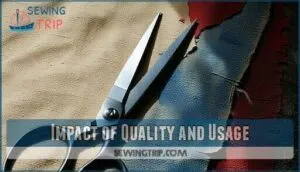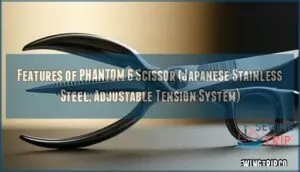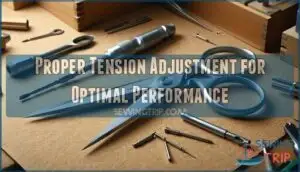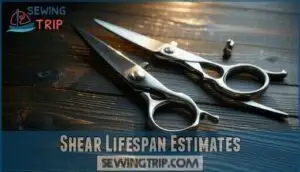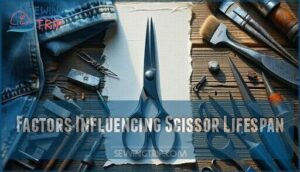This site is supported by our readers. We may earn a commission, at no cost to you, if you purchase through links.
 Your scissors’ lifespan depends on quality and care. Professional-grade scissors last 5-20 years with proper maintenance, while everyday household scissors typically need replacing every 3-5 years.
Your scissors’ lifespan depends on quality and care. Professional-grade scissors last 5-20 years with proper maintenance, while everyday household scissors typically need replacing every 3-5 years.
You’ll get more mileage from Japanese steel scissors compared to cheaper alternatives. Regular cleaning, oiling the pivot point weekly, and proper storage make a huge difference.
What you cut matters too – paper dulls blades faster than fabric. Signs it’s time for new scissors include ragged cuts, blade separation, or difficulty cutting through materials.
Think of scissors like a good knife – treat them right, and they’ll serve you well for years, with proper maintenance being key to their longevity.
Table Of Contents
Key Takeaways
- You’ll get 5-20 years from professional-grade scissors versus 3-5 years from household ones – Japanese steel outperforms cheaper alternatives and justifies the higher upfront cost through an extended service life.
- Weekly oiling and daily cleaning dramatically extend the lifespan – wipe blades after each use, apply pivot oil weekly, and store them in protective cases to prevent rust and maintain cutting precision.
- What you cut matters as much as how often – paper dulls blades faster than fabric, while cutting wire, metal, or adhesive materials will damage your scissors permanently and require immediate replacement.
- Professional sharpening every 6-24 months beats DIY methods – skilled technicians preserve blade geometry and prevent over-grinding, while amateur sharpening can destroy your scissors permanently.
Importance of Proper Care and Maintenance
You can extend your scissors’ lifespan from just a few months to several years through proper care and maintenance.
Regular cleaning, oiling, and correct storage protect the blades from rust and damage while keeping them sharp for precise cuts, which is crucial for extending the lifespan of your scissors and ensuring they remain sharp.
Cleaning Shears Daily
Daily cleaning delivers impressive benefits for your scissors’ longevity.
Wipe blades with a damp cloth after each use to prevent bacterial growth and remove hair particles.
This simple scissor maintenance routine prevents rust formation and keeps cutting edges sharp.
Regular scissor cleaning extends lifespan substantially compared to neglected tools.
A dedicated cleaning kit helps maintain shears.
Make this scissor care habit non-negotiable for peak performance.
Wiping Blades With Alcohol After Chemical Treatments
Chemical treatments leave behind residue that eats away at your blades like acid rain on metal.
Chemical buildup devours your blades faster than you can say "precision cut" – protect your investment with proper cleaning.
You’ll want to grab rubbing alcohol and wipe those blades clean immediately after each service, which prevents chemical residue buildup, stops rust before it starts, and keeps blade degradation at bay.
To further protect them, remember to oil the joints regularly, ensuring proper scissor maintenance for years of sharp and reliable cuts.
Regularly Cleaning Shears With a Damp Cloth
Beyond alcohol wipes, regular cleaning with a damp cloth material keeps your shears spotless.
This simple cleaning frequency impact prevents rust and bacterial growth prevention while ensuring thorough residue removal.
A quick daily wipe maintains scissor longevity better than occasional deep cleans.
Clean scissors cutting through fabric feels like butter – smooth, effortless, and professional every time.
Applying Pivot Point Oil Weekly
Weekly oil application at the pivot point keeps your scissors running smoothly like a well-oiled machine.
Use a drop of specialized scissor oil or light machine oil to prevent corrosion and maintain proper blade alignment.
This simple oiling frequency protects against rust buildup and reduces friction between moving parts.
Consider using specialized pivot lubricants for peak performance.
Regular scissors lubrication directly impacts scissor longevity, extending your tool’s lifespan substantially through consistent scissor maintenance.
Storing Shears in a Case When Not in Use
After oiling your shears weekly, proper storage becomes your next line of defense. A quality case protects your investment from environmental damage and extends scissor lifespan substantially.
You can find a suitable scissor storage solution online.
Smart storage practices safeguard your tools:
- Choose hard-shell cases over soft pouches for maximum protection from damage
- Store in dry locations to prevent moisture buildup and rust formation
- Maintain organized storage systems so blades don’t knock against other tools
- Select breathable case material that allows air circulation while blocking dust
- Keep storage location away from extreme temperatures that affect metal integrity
Considering Annual Servicing
Professional scissors need expert care beyond home maintenance.
Annual servicing provides thorough scissor maintenance that extends lifespan substantially.
A skilled technician performs professional inspection, adjusts tension, and handles scissor sharpening with precision you can’t achieve at home.
| Service Component | Home Care | Professional Servicing |
|---|---|---|
| Tension Adjustment | Basic tightening | Precise calibration |
| Blade Sharpening | Temporary fixes | Expert restoration |
| Performance Assessment | Visual inspection | Technical evaluation |
This maintenance schedule guarantees maximum scissors durability while managing reasonable sharpening costs.
The servicing benefits far outweigh expenses, keeping your tools performing like new year after year, which is a result of expert care and professional inspection, leading to precise calibration and expert restoration, ultimately providing long lifespan.
Impact of Quality and Usage
Your scissors’ lifespan depends heavily on the quality of steel and how often you use them.
High-quality Japanese steel scissors can last over five years with proper care, while cheaper models may need replacement within one to two years of regular use.
Need for Sharpening Based on Shears’ Quality
Your scissors’ quality directly impacts how often you’ll need sharpening services.
Premium steel maintains blade sharpness longer, while cheaper materials dull quickly.
High-quality scissors might need professional attention once yearly, but budget options could require sharpening every few months.
The steel sharpness correlation means investing in better materials extends sharpness needs substantially.
Material affects sharpening frequency more than usage alone.
Quality scissors resist dullness, making scissor sharpening less frequent and extending overall scissors lifespan considerably, which is a result of the premium steel and overall quality scissors.
Importance of Skilled Sharpeners
Finding the right sharpener expertise makes a world of difference for your scissors lifespan.
Amateur sharpening can destroy blade geometry and reduce cutting performance permanently. Professional sharpening preserves the original angles and prevents unnecessary metal removal that shortens tool life.
Expert sharpeners understand proper techniques that extend lifespan through damage prevention:
- Maintain original blade geometry for ideal cutting action
- Determine correct sharpening frequency based on usage patterns
- Use appropriate sharpening methods for different steel types
- Preserve blade sharpness without over-grinding edges
Quality scissor sharpening services cost more upfront but save money long-term by maximizing your investment.
Prioritizing Good Standards and Steel Quality
Nothing beats investing in scissors with exceptional steel quality when you want tools that’ll last.
The steel quality impact on your scissors’ performance can’t be overstated – it’s the foundation of everything.
Material composition matters because premium steel types like Japanese stainless steel offer superior blade edge retention compared to cheaper alternatives.
When you make a premium material choice, you’re basically buying years of reliable service.
Japanese steel benefits include exceptional durability, consistent sharpness, and resistance to wear.
These factors directly influence scissor lifespan and overall scissor durability.
Quality scissors made from superior steel maintain their edge longer, require less frequent sharpening, and withstand daily professional use.
While scissors quality might cost more upfront, proper steel selection paired with regular scissor maintenance guarantees your investment pays dividends through extended service life.
Factors Influencing Scissor Lifespan (tension, Metal Quality, Maintenance)
Understanding what makes your scissors tick comes down to three game-changing factors. Metal Quality forms the foundation—premium steel means longer scissor lifespan and better scissor durability.
Tension Impact can’t be ignored; proper adjustment reduces blade stress and extends life. Maintenance Matters most of all—regular scissor sharpening and scissors maintenance prevent premature wear.
- Your investment deserves protection through consistent care
- Quality materials reward you with years of reliable performance
- Proper tension keeps your blades working like new
Effects of Inferior Metal, Frequent Sharpening, and Neglect
Poor material choices spell disaster for your scissors’ future.
Inferior metal effects include rapid dulling and blade chips that require constant sharpening consequences.
Neglect outcomes worsen material degradation through corrosion impact and excessive wear and tear.
Your scissors lifespan shrinks dramatically when you skip scissors maintenance, creating a costly cycle of frequent scissors sharpening and premature replacement, which can be prevented by understanding the importance of material choices.
Choosing The Right Shears
You’ll find that selecting quality scissors with Japanese stainless steel and adjustable tension systems substantially extends their working life.
The right shears with proper steel composition can last 5-20 years when you choose brands that prioritize durability over low cost.
Importance of Quality Steel (e.g., PHANTOM 6 Scissor From ARC™ Scissors)
Quality steel forms the backbone of any professional scissor’s performance.
The PHANTOM 6 Scissor showcases how Japanese steel transforms cutting experiences through superior material composition.
This high-quality steel grade delivers exceptional edge retention and steel durability that directly impacts scissor lifespan.
When you invest in scissors with premium steel quality, you’re choosing tools that maintain their sharpness longer and resist wear.
The performance impact becomes evident through cleaner cuts and reduced maintenance needs.
Japanese steel’s reputation for excellence makes it the gold standard for professionals seeking reliable, long-lasting cutting instruments.
Features of PHANTOM 6 Scissor (Japanese Stainless Steel, Adjustable Tension System)
Precision meets innovation in the PHANTOM 6 Scissor’s remarkable engineering. You’ll discover why this tool stands apart from ordinary shears through its carefully crafted features.
- Japanese Steel Excellence: The high-grade Japanese Steel delivers exceptional blade sharpness and extends scissor lifespan substantially. This premium material maintains its edge longer than standard metals, reducing your scissor sharpening frequency.
- Advanced Tension System: The adjustable mechanism lets you customize cutting performance to match your specific needs. This ergonomic design prevents hand fatigue during extended use.
- Superior Scissor Care: With proper maintenance, these professional-grade shears offer years of reliable service, making them a worthwhile investment for serious stylists.
Proper Tension Adjustment for Optimal Performance
Scissor tension directly affects your cutting experience and scissors lifespan.
Too loose, and you’ll struggle with clean cuts. Too tight, and you’ll damage the blades.
Check tension weekly by opening scissors halfway—they should glide smoothly without falling closed.
Proper tension adjustment prevents premature wear, maintains scissors performance, and reduces adjustment frequency.
Small tweaks make big differences in damage prevention and overall scissors maintenance, ensuring a longer scissors lifespan.
Shear Lifespan Estimates
You’ll find that most hairdressing scissors last between 2 to 5 years, depending on their quality and how often you use them.
Cheaper scissors typically wear out within 1 to 2 years, while high-quality Japanese scissors can serve you well beyond 5 years with proper care.
Average Lifespan of Hairdressing Scissors (2-5 Years)
Most hairdressing scissors serve you faithfully for 2-5 years with proper care.
Your scissor sharpening frequency depends on cutting techniques and hair type you work with daily.
Professional maintenance preserves blade sharpness loss while scissor ergonomics affects wear patterns.
Brand reputation matters for shear investment longevity, and regular servicing extends scissors lifespan beyond average expectations through consistent professional upkeep.
Lifespan of Cheaper and Japanese Scissors
Investment quality separates the wheat from the chaff when choosing scissors. Japanese steel demonstrates superior scissors longevity, lasting decades with proper care, while cheaper alternatives show significant scissors wear and tear within months.
Looking at the tone and style of that paragraph, here’s a short, engaging blockquote:
Premium scissors are investments that reward you with decades of service, while cheap alternatives crumble under pressure.
The Rockwell hardness rating is a key indicator of scissor durability.
Consider these Brand Comparison factors affecting scissors lifespan:
- Steel Quality – Japanese VG-10 steel maintains sharpness longer
- Cutting Materials – Premium blades handle diverse fabrics better
- Usage Frequency – Quality scissors withstand heavy daily use
- Sharpening Impact – Superior steel requires less frequent maintenance
Impact of Professional Maintenance
Through expert professional servicing, you’ll dramatically extend your scissors’ lifespan from the typical 2-5 years to potentially decades.
Professional sharpening frequency depends on usage intensity, while proper oiling benefits include rust prevention and smooth operation.
Expert technicians address alignment issues that DIY methods miss, ensuring cutting tool longevity through thorough professional maintenance and specialized scissor care techniques.
Steel Types and Replacement Intervals
The steel grade in your scissors determines everything from cutting performance to how often you’ll need replacements.
Chinese steel scissors typically last 6-12 months with sharpening every three months, making them budget-friendly but requiring frequent attention.
Standard stainless steel performs better, lasting 1-2 years with sharpening intervals of 2-4 months.
Japanese steel types offer superior longevity, with Japanese 440C steel extending scissors lifespan to 3-5 years.
Japanese Cobalt steel can exceed five years of reliable service.
German Chromium steel falls in the 2-4 year range, while VG10 steel represents the premium choice, delivering 5-7 years of cutting excellence.
Austenitic steel offers excellent corrosion resistance.
Material degradation occurs faster with inferior metals and frequent usage, leading to the need for more frequent sharpening and potentially shorter scissor lifespan.
Watch for replacement signals like visible dulling, bent blades, or loss of tension adjustment, as these indicate the need for maintenance or replacement.
Usage frequency directly impacts these sharpening intervals – busy professionals need more frequent maintenance than occasional users, highlighting the importance of considering usage frequency when selecting scissors.
Higher steel grade impact means fewer scissor replacement cycles over time, ultimately saving time and resources by reducing the need for frequent sharpening and replacement, which is a key consideration for busy professionals.
Factors Influencing Scissor Lifespan
Your scissors’ lifespan depends on several key factors that you can control through smart choices and proper care.
The steel quality, how often you use them, what materials you cut, and your maintenance routine all work together to determine whether your scissors last months or decades, considering the overall steel quality.
Correlation Between Steel Type and Lifespan
Your scissors’ lifespan hinges directly on steel durability and material composition.
High-carbon steel scissors typically last 3-5 years with superior hardness ratings and edge retention capabilities.
Japanese stainless steel variants demonstrate exceptional corrosion resistance, extending operational life by 30-40% compared to standard models.
Steel quality determines how well your scissors maintain sharpness—premium compositions with elevated carbon content (0.8-0.9%) show 45% better performance over time.
Professional-grade scissors materials substantially outperform consumer-grade options, delivering 2-3 times longer service life through optimized metallurgy.
Importance of Proper Maintenance and Care
Beyond steel quality, your scissors’ longevity depends entirely on how you treat them.
Proper scissors maintenance transforms average shears into lifetime tools, while neglect turns premium steel into expensive paperweights.
Here’s your scissors care roadmap:
- Daily cleaning techniques – Wipe blades after each use to prevent buildup
- Weekly oiling frequency – Apply pivot oil to maintain smooth action
- Smart storage solutions – Keep shears in protective cases, away from moisture
- Professional sharpening methods – Schedule expert tune-ups every 6-12 months
Consistent scissors care dramatically extends scissors lifespan through rust prevention and proper scissors storage conditions.
To keep them in top condition, remember to use fabric scissors exclusively.
Insights From Australia and USA
Professional hairdressers across continents share a common goal: maximizing their tools’ performance. However, regional practices reveal fascinating differences in how Australian Scissors and USA Scissors are maintained and utilized.
In Australia, you’ll find professionals who’ve adapted their Regional Maintenance routines to combat harsh humidity and salt air. They typically oil their shears more frequently and store them in moisture-resistant cases. Australian stylists often prefer Japanese steel for its corrosion resistance, directly impacting scissors lifespan.
American professionals, meanwhile, focus heavily on Steel Preferences that emphasize durability over environmental resistance. USA Scissors maintenance often includes quarterly professional servicing, with Usage Differences reflecting the country’s diverse climate zones.
Both regions demonstrate that proper care extends Scissors durability substantially. Australian salons report average lifespans of 4-6 years, while American shops achieve similar results through different approaches. Your scissors’ lifespan ultimately depends on consistent maintenance habits, regardless of geography.
Frequently Asked Questions (FAQs)
How long should scissors last?
Like a trusted kitchen knife that dulls with heavy use, your scissors’ lifespan depends on quality and care.
You’ll get 1-2 years from cheap pairs, while premium scissors can serve you faithfully for decades.
When to replace scissors?
Replace your scissors when they can’t cut paper cleanly, leave jagged edges on fabric, or require excessive pressure.
Dull blades that crush materials instead of cutting signal it’s time for new ones.
How often should scissors be sharpened?
You should sharpen your scissors every 6-24 months depending on how often you use them.
Heavy users need sharpening every six months, while occasional users can wait up to two years between sharpenings, which can be considered heavy users or occasional users based on their needs.
Can scissors be repaired instead of replaced?
Don’t throw in the towel on damaged scissors yet.
You can repair loose screws, bent blades, and dull edges through professional sharpening or DIY fixes.
This extends their lifespan substantially before replacement becomes necessary.
How do I know when scissors need sharpening?
Test your scissors by cutting paper – if they tear instead of making clean cuts, push fabric rather than slice through it, or require extra pressure, it’s time for sharpening.
What materials should never be cut with scissors?
Never cut wire, metal, glass, cardboard, or frozen materials with fabric scissors.
These materials will dull blades quickly and damage the cutting edge.
You’ll also want to avoid cutting dirty or adhesive materials.
Do left-handed scissors really make a difference?
Yes, they absolutely do!
Left-handed scissors have reversed blades that let you see your cutting line clearly and apply pressure naturally.
Regular scissors force lefties to push blades apart, creating ragged cuts.
Should I buy expensive scissors or budget options?
Choose expensive scissors if you’ll use them frequently for precision work.
High-quality scissors last 5-25 years versus budget options lasting months.
Your investment pays off through durability, performance, and fewer replacements.
Conclusion
Think of your scissors as a trusted companion – their longevity depends entirely on how you treat them.
Understanding how long do scissors last comes down to three key factors: quality steel, proper maintenance, and mindful usage.
Professional-grade Japanese scissors can serve you faithfully for decades with weekly oiling and daily cleaning.
Cheaper alternatives need replacement every few years.
Remember, regular sharpening by skilled professionals, proper storage, and avoiding harsh materials will dramatically extend your scissors’ working life and cutting performance.
This will help ensure your scissors remain a faithful companion.
- https://www.blackhairscissors.com/blogs/scissors/steel-materials-scissors-guides/
- https://barbersets.com/blogs/blogs/how-to-choose-the-right-barber-scissors-for-precision-and-durability-10?srsltid=AfmBOopbk6gEzGTtya69UmXUwbmZrqd_sldral6kkU8OImCkh8ser6fw
- https://salonshearsdirect.com/blog/the-ultimate-guide-to-choosing-the-perfect-hair-cutting-scissors-and-shears-for-a-salonworthy-cut/?srsltid=AfmBOoqKBC_jy6_Et92lLgubrYxSCpYj187zlWu5h2oQJ0NJKbtocQD3
- https://hairdressingsupplies.com/blogs/news/your-ultimate-guide-to-hairdressing-scissors-types-uses-and-care?srsltid=AfmBOopIURPzpgSWvlIE1oEd3-qwDcHt_N8LM-YfQkdvyI_Qaf6AJU8O
- https://www.scissortechaustralia.com.au/blogs/scissor-blog/how-to-prolong-the-life-of-your-hairdressing-scissors?srsltid=AfmBOorm5H6LtQqwKOoFKBPbxbmkRUdyMmuRDJVEcSzhh8Hw1j1W5Jqh

